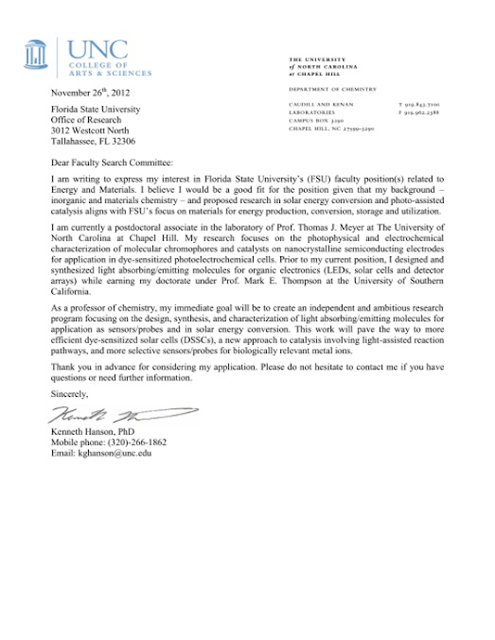This blog posts continues my “Get a Job, Ken!” series. My last post focused on writing research proposals. This post describes the other pieces of my application package.
There isn’t a standard, one-size-fits-all set of application materials for all faculty job openings, but the majority ask for a cover letter, curriculum vitae (CV) and three letters of recommendation. A few universities also asked for additional items like a teaching statement, a diversity statement, copies of graduate school transcripts, or 4-5 publications.
Cover letter
I personalized the cover letter to each university. Yet, for my own sanity, I reused the same basic cover letter structure:
Paragraph one: I included a sentence that stated my general area of research. This is important, especially for general call job posts. When search committee chairs or their assistants start organizing applications one of their first goals is to identify the correct person to review it. They—and especially the candidate—want the proposals matched with a reviewer from a similar research domain. Including a sentence that clearly defines your area of research makes the alignment process easier and avoids, for example, having a biochemist assess an inorganic proposal or vice versa.
In the first paragraph I also made sure to note any faculty or consortiums at the institution whose research aligned with mine in ways that could lead to possible collaborations. I included this to demonstrate how I could fit into the departments’ research theme.
Below is the cover letter I submitted to FSU.
CV
CVs vary greatly from one person to the next. I don’t know what the ‘right’ CV format is, but in case it’s helpful I am sharing, a copy of my current CV formatting (pdf).
Letters of Recommendation
To help give my references a few months to prepare recommendation letters, I emailed them a few months in advance (July and August). Then, a few weeks before the deadline, I sent a friendly reminder.
Other Requested Application Materials
Teaching Statement
Half of the openings I applied to asked for a Teaching Statement or, as some describe it, a Statement of Teaching Philosophy. But if we are going to be perfectly honest, teaching statements are much more important when applying to primarily undergraduate institutions. Some of the faculty I met with during interviews said they never saw my teaching statement or new I had submitted one. Regardless, in my teaching statement I mentioned my past experiences and the philosophies that shape my teaching style. While R1 institutions are more interested in research agendas, they are also looking to hire someone to fill any departmental teaching gaps. Acknowledging this, I explicitly listed classes I could teach. That way it is easier for the search committee to see how well I fit their needs. For example, I wrote:
“Envisioning myself as a future chemistry professor, there are a number of courses that--given the opportunity--I would be very comfortable teaching. These courses include General Chemistry (105a/b, 115a/b), Inorganic Chemistry (453, 515) and Chemical Nanotechnology (455).”
The teaching statement is also an opportunity to share a little bit about who you are as a person. The search committee is not just hiring a scientist and teacher, they’re also looking for a colleague and possible friend.
Diversity Statement
A diversity statement was only requested by University of California schools and served as an opportunity to express my awareness of and intention to help address the disproportionate involvement of female, African American, Hispanic, and Native American students in science, technology, engineering, and mathematics (STEM) fields. The diversity statement was the space to describe my current efforts to close this gap and how I plan to continue these efforts if hired.
While a diversity statement is currently only requested by University of California institutions, I would not be surprised if this request soon expands further. Expanding access and representation in STEM fields is a pressing issue. If these inequities are not addressed there will be a serious impact on the number of people prepared to enter STEM fields, especially as the demographics of the United States change. Recognizing this, the NSF has also increased the rigor necessary in the ‘broader impacts’ component of their proposals. It’s no longer acceptable to simply say “I’m going to go to a high school and give a talk” or “I am going to create a new graduate class.” Plans for expanding STEM representation are now expected to be more thought out and impactful and this is especially the case for career awards.
Rough Budget Proposal
One job application asked us to submit a rough budget proposal. This was a unique request and I am guessing the department had a limited budget and probably couldn’t support a $500,000 piece of equipment. This request, while unusual, seemed completely reasonable since departments want to optimize their time and only invite interviewees whose research they could support. This early request also proved to be a convenience later since I had a rough budget proposal prepared before going into the interviews.
In my next post I’ll talk about the actual application submission process.


No comments:
Post a Comment
looks like Blogger doesn't work with anonymous comments from Chrome browsers at the moment - works in Microsoft Edge, or from Chrome with a Blogger account - sorry! CJ 3/21/20